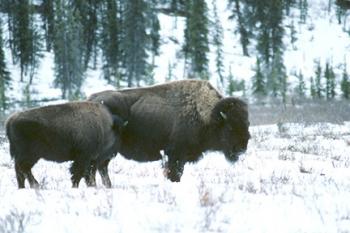Image Caption
By Shari Narine
Windspeaker Contributor
EDMONTON
The accidental discovery of a fossil confirms that the bison that the First Nations and Métis people followed across the Great Plains are descended from bison that originated from Asia.
“We can now say with good confidence that all bison in North America are descended from animals that came across the (Bering) land bridge during an ice age sometime between 190- 130,000 years ago,” said Alberto Reyes, a geologist from the Department of Earth and Atmospheric Sciences at the University of Alberta.
It was Reyes who discovered the bison’s metacarpal in 2006 at Ch’ijee’s Bluff in the Vuntut Gwitchin Territory in northern Yukon when he was there doing work for his doctorate. He was studying how permafrost was affected by ancient periods of global warming.
“That area has been a real hotbed of ice age paleontology over the last several decades,” he said.
But it wasn’t until four years later, as he revisited his notes and analyzed the age of the volcanic ash the fossil was found adjacent to, that he began to grasp that his discovery might be significant.
“I realized, ‘oh wait, this is a pretty old bison. This could be interesting’,” he said.
He worked with paleogeneticist Beth Shapiro at the University of California Santa Cruz, who did the DNA work.
Reyes says it took time to develop the technique to get the DNA, as it was degraded. The fossil was determined to be 130,000 years old.
“It’s actually pretty astounding to think that we can extract DNA from fossils that are over 100,000 years old,” he said.
Using the Yukon fossil and a bison fossil taken from Snowmass, Colo., and determined to be 10,000-20,000 years younger, and comparing the genomes to additional Siberian and North American bison, the researchers determined that a common maternal ancestor arrived between 130,000 to 195,000 years ago. That genetic testing was backed up by geological evidence.
“We know there was a period of low sea level when animals could have crossed over from Asia, across the Bering Land Bridge. So those two different lines of evidence converge on that time line,” said Reyes.
Considering the geological time scales, the introduction of bison to North America makes them relative newcomers.
“You can think of them as almost an evasive species that came over into North America, spread very rapidly, and they would have had a pretty large ecological impact across North America,” said Reyes.
In about 20,000 years, the bison dispersed throughout North America, evolving and colonizing the continent. They became critical to the way of life for the Indigenous peoples on the Great Plains, who followed them for hunting and used every part of the bison.
When the Europeans slaughtered the bison, the impact on Indigenous peoples was far-reaching.
Reyes says it’s amazing to consider how rapidly bison were nearly wiped from the Plains.
“In North America, you’re looking at 10-, 11-, 12,000 years of hunting and really in the last few hundred years doing the major damage to wipe them out. That’s a pretty major impact,” he said.
Reyes is heartened by efforts made to reintroduce bison to Banff National Park and the Yukon.”
“I like the idea of these animals taking their ecological role back,” he said. “I think these are iconic animals and I think we should celebrate trying to restore them.”
The new research undertaken by Reyes and University of Alberta colleague Duane Froese is outlined in a paper entitled “Fossil and genomic evidence constrains the timing of bison arrival in North America,’ and is published in the March 2017 edition of Proceedings of the National Academy of Sciences.

